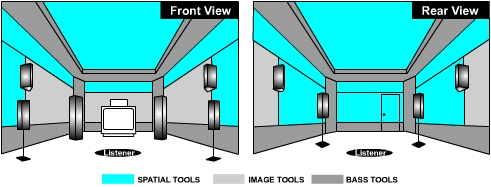Home Cinema Acoustics
Home Cinema Acoustic Treatment
The sound that you hear in a room is far more influenced by the placement of yourself, the placement of the speakers and the acoustic performance of the room’s surface and contents than it is by the quality of the speakers and electronics.
The tone and timbre of the speakers can also vary significantly depending on the speaker / listener positions and the room acoustics.
The acoustic distortion introduced by the room can be so influential that it dominates the overall sonic impression.
To deal with these problems you need to address two main issues. One is for frequencies in the low region below 500Hz; the other is for the other frequencies above 500z.
Below 500Hz you need to focus on the interference at the listening position between the loudspeakers and the adjacent wall/floor/ceiling boundaries, as well as the coupling between the speakers and yourself with the modal response of the room.
These low frequency forms of acoustical distortion can be addressed with proper placement of loudspeakers and listening position, as well as the application of dedicated low-frequency absorbers.
Above 300 Hz you are dealing with more direct reflections which result in comb filtering and the lack of adequate sound diffusion. Comb filtering can be reduced through careful placement of absorptive and diffusive surface treatment.
When building a home cinema or listening room try to think about the low-frequency control first because once the room is built any standing wave problems will be harder to reduce.
Also consider the speaker/listener positions as modal coupling can be optimised by optimal speaker/listener positioning. The application of Bass Traps or other low frequency acoustic control products will then be more efficient and effective.
When designing a new room it is a good idea to reserve a 300mm deep space around the perimeter of the room for acoustic treatment.
It is also often convenient to utilise wall/ceiling soffits to address low-frequency control, HVAC, wiring and lighting as space can often be at a premium.
This area can also be well utilised to provide a ‘ceiling cloud’ over the listening position area to conceal Modex Bass Traps as well as providing absorptive and diffusive elements.
It is also a good idea to decide at the design stage if the acoustic treatment will be completely concealed or revealed or some combination of the two.
Concealment methods usually involve our acoustic fabric stretched over a wooden framework or the treatment built into cavities behind wall constructions, then fabric covered.
Front Wall
Because the front wall immediately receives the omni-directional low frequency sound from the bass speakers, it typically needs to be covered with at least 100mm of thick absorption or even better Bass Traps.
Corner mounting Bass Traps should be mounted in the wall / ceiling or wall / wall corners. Try to position the screen at least 300mm into the room so that there is space for acoustic treatment behind it.
Rear Wall
The rear wall is usually treated with some kind of exposed or concealed acoustic diffuser system to uniformly diffuse sound across the listening area, thus heightening the surround sensation.
If possible the listener should be seated at least 1.2m from the rear wall. Additional low frequency treatment can be placed below and surrounding the diffusers if necessary.
Left / Right Walls
The front of the room, from the screen to the first row of seats, should ideally be a mixture of absorption and diffusion which can be achieved with a combination of acoustic panel types, typically 100mm in depth.
The rear side walls are usually made diffusive, so that the surround channels can be uniformly diffused. For lateral low-frequency modal control a thick bass absorbing system can be included above and below the diffusers if necessary.
For lateral modal control, side wall Bass Traps are important.
Ceiling
The ceiling should ideally be diffusive, or at least mixed by utilising some additional absorber panels. Typically T-grid compatible are used when there is the possibility of using a heavy duty ceiling grid.
If a lightweight surface treatment is required then lighter units would be the better choice.

